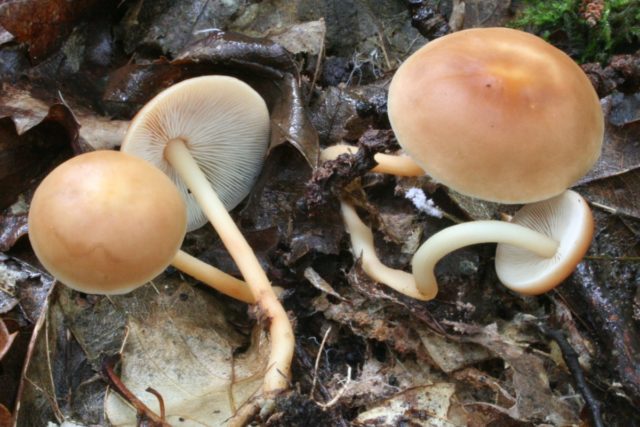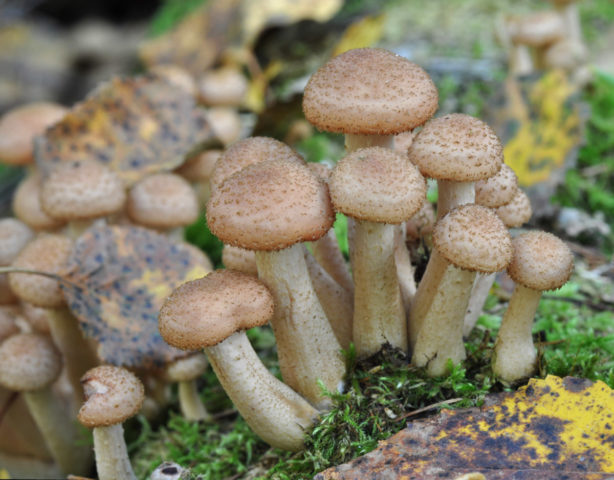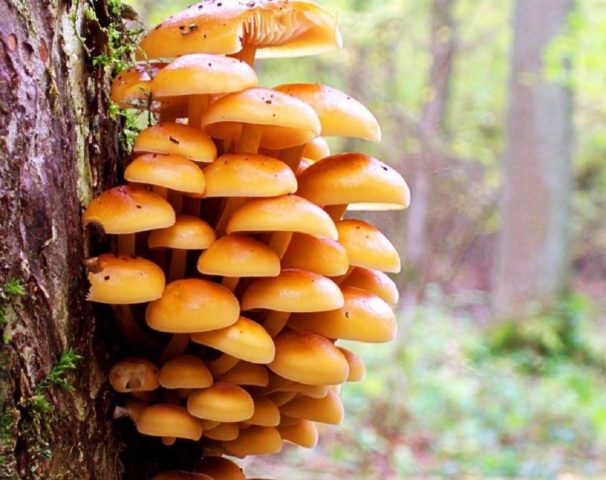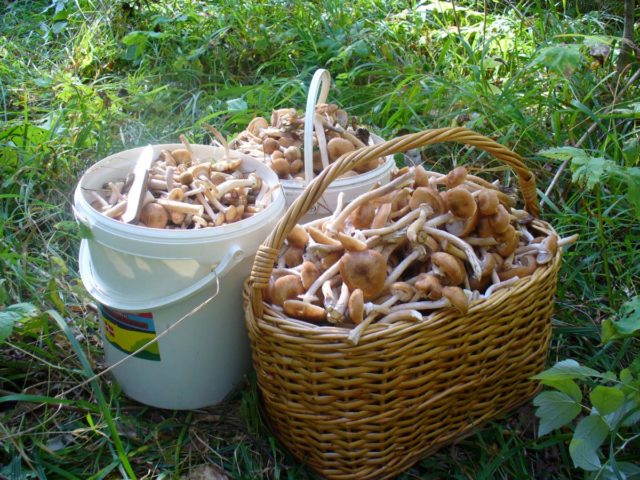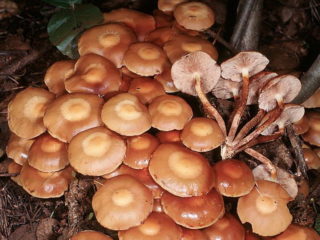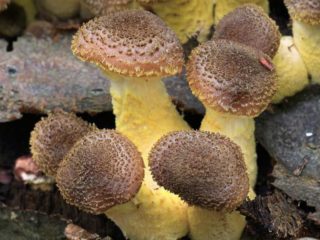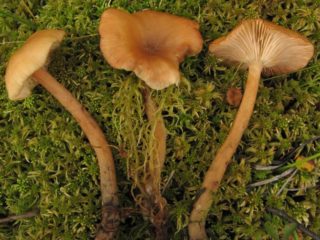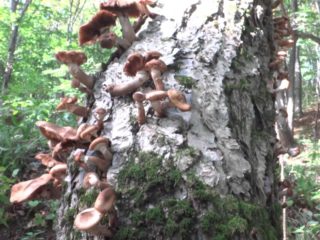Content
Kursk region is one of those regions that can boast of many mushroom spots. More than a hundred species are found here, but honey mushrooms are the most collected of them. Experienced mushroom pickers know that these mushrooms form whole families, and if it is possible to find at least a few specimens, then their numerous relatives will surely grow nearby. Honey mushrooms in the Kursk region are found throughout the season in the presence of favorable conditions, so you just need to figure out which species and in which area you can collect.
Types of edible mushrooms in Kursk and the region
These mushrooms are highly revered by many adherents of quiet hunting, despite the fact that they are inferior in taste to many species. This is due to the fact that their spongy pulp absorbs spices and marinades well, so you can make preparations for the winter from them. In addition, they grow massively, so if you find a mushroom spot, you can pick up a whole basket in 5-10 minutes.
The main edible species growing in the Kursk region:
- Spring honey or wood-loving money. Grows on mossy litter, rotten stumps and protruding tree roots. The color of the cap varies from reddish to yellow-brown. The diameter of the upper part reaches 3-7 cm, and the height of the leg is 5 cm. The taste is below average, but since they grow in the season when there are few mushrooms, interest in them increases significantly.
- Summer honey agaric. This species is distinguished by its increased taste and is often found. The fruiting period begins in June and lasts until October. The hat is flat-spread with a tubercle in the center, reddish-brown, reaches a diameter of 2-7 cm. The leg is woody, light brown in color, it is not used for food.
- Autumn real honey. The most common species in the Kursk region. It can be harvested from early September to late November if conditions are favorable. Differs in high taste and is suitable for preparation of winter preparations. The color of the cap can vary from mustard yellow to dark brown. In young specimens, a light film is present on the reverse side of the upper part, which, after rupture, forms a ring on the leg.
- Winter honey or flammulina... This species bears fruit in colonies and is found in an intergrown form. The mushroom grows at temperatures from 0 to +5 degrees. Fruiting begins in November and lasts until the end of January. The hat of the winter mushroom is yellow-brown in color, but closer to the center it darkens. Its diameter reaches from 2 to 10 cm. Winter honey agaric is suitable for any processing.
Where honey mushrooms grow in the Kursk region
Honey mushrooms in the Kursk region are easy to find if you know where to look for them. Therefore, experienced mushroom pickers say that in the forest you need to move slowly and carefully examine the mossy stumps and trunks, as well as look at the base of the trees.
In which forests honey mushrooms grow in Kursk and the region
Honey mushrooms in the Kursk region grow in any forest plantation or forest area. Fallen trunks, rotten stumps, decaying trees are the favorite growing places for this species.
They can also be found in a sunny meadow in the grass. This is due to the fact that many trees rot, and their roots extend far from the trunk. So the impression is that the mushrooms grow on the soil.
In which districts of the Kursk region honey mushrooms grow
In the Kursk region, there are several regions where, according to experienced mushroom pickers, you can definitely find fruitful places.
Lovers of quiet hunting are suitable for the following areas:
- Kursk;
- October;
- Zheleznogorsky;
- Dmitrievsky;
- Oboyansky.
Forests where you can collect honey mushrooms in the Kursk region
Honey mushrooms grow in the forests of the Kursk region. not far from the Lvovskaya station near the village of Lagovsky. In this place, especially in the sparse birch forest, you can find numerous families of this species. Also, the mushroom route extends from the village. Meshcherskoye to the Kolkhoznaya station. On both sides of the road there is a forest area where you can pick up a large number of mushrooms.
Many experienced mushroom pickers recommend looking for mushrooms in the Kursk region in the forest near the village of Zhokhovo and Panino. In their opinion, there is a large number of mushroom places here, so it will not be difficult to collect and make supplies.
In Kursk, there are honey mushrooms also in the forest near the village of Nikonovo and further along the banks of the Rozhaya River.
When can you collect honey mushrooms in Kursk and the Kursk region in 2021
It is possible to collect in the Kursk region at different times of the year, since all known edible species of these mushrooms grow in this region. But it all depends on the availability of favorable conditions for their growth.
When to collect spring and summer mushrooms in the Kursk region
The ripening period of the spring species in the Kursk region falls on the beginning of May. It lasts all June and ends in July. But these dates can shift in the absence of seasonal precipitation, since in dry and hot weather, the development of mycelium stops.
Now in Kursk you can find summer mushrooms, as regular rains and moderate temperatures contribute to their massive growth. The fruiting period of this species begins in August and ends in October.
When autumn mushrooms grow in Kursk
Autumn mushrooms in the Kursk region in 2021 can be harvested from the beginning of September to the end of October. The duration of this period depends on the onset of the first frost.
The season for collecting winter mushrooms in the Kursk region
Winter mushrooms can be harvested in Kursk from November and during two months of winter. But the main condition for their growth is temperatures above 0 degrees. Therefore, it is worth going out on a quiet hunt during a thaw.
Collection rules
When collecting, you should adhere to certain rules, which will help protect the mycelium from mechanical damage. A careful attitude will allow you to come to the old place for a new portion of mushrooms every year.
When picking, mushrooms should not be pulled out, but rather cut off with a knife. It is also allowed to twist each specimen from the mycelium by turning it around the axis. Only young mushrooms should be selected from the family, since the spongy pulp of overgrown ones is capable of accumulating harmful toxins.
Picked mushrooms should first be cleaned of grass and soil, and then put in the basket with the cap up or on one side.
How to find out if mushrooms have appeared in the Kursk region
Experienced mushroom pickers advise to go for the harvest to the forest, which is at least 30 years old. A large number of rotten stumps have already accumulated in it, on which this species prefers to grow.
Reproduction of the mycelium begins at a temperature of + 3- + 4 degrees. In this mode, the growth of the fungus continues for 30 days. The germination rate largely depends on the jumps in daytime and nighttime temperatures.
The most favorable conditions for the active growth of mycelium are temperatures within + 10- + 26 degrees and moderate humidity. With this mode, the growth of the fungus continues for 6-8 days. The daily growth is 2-2.5 cm.
The main signs of their appearance:
- moderate humidity of air and soil - within 55-60%;
- temperature within + 10- + 17 degrees without sudden jumps.
Conclusion
Honey mushrooms in the Kursk region really grow in large numbers. But when going to the forest for a harvest, it is worth considering the terms of fruiting of different species and the presence of favorable conditions for their germination. And for beginners, it is better to be patient, since it is not always possible to find mushroom places right away.
